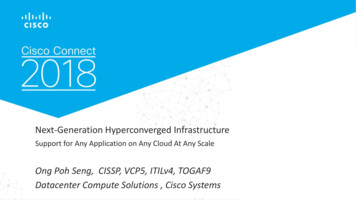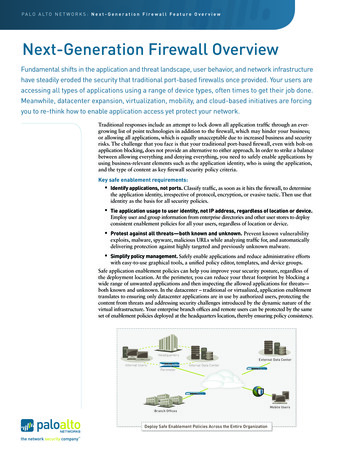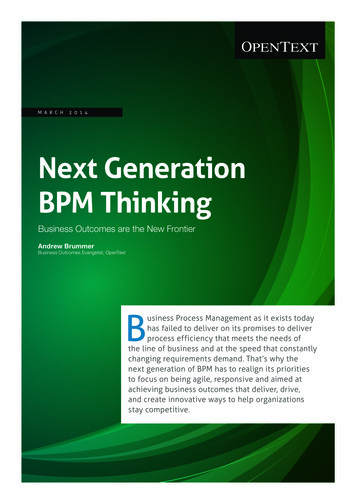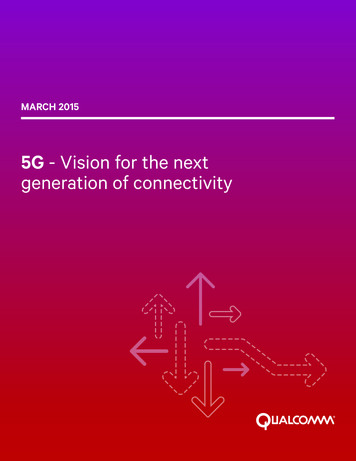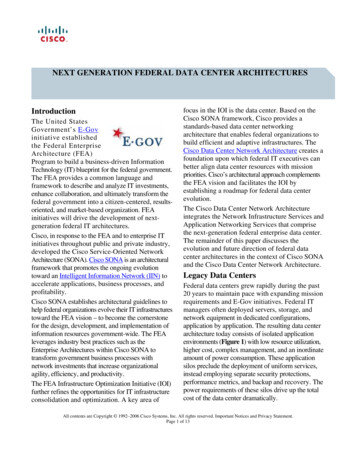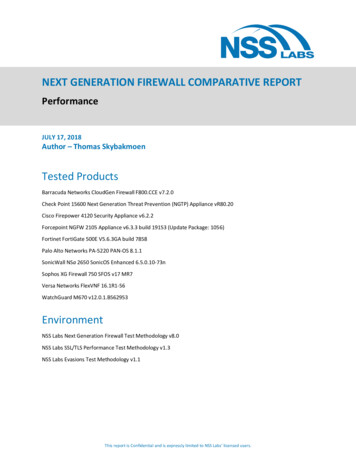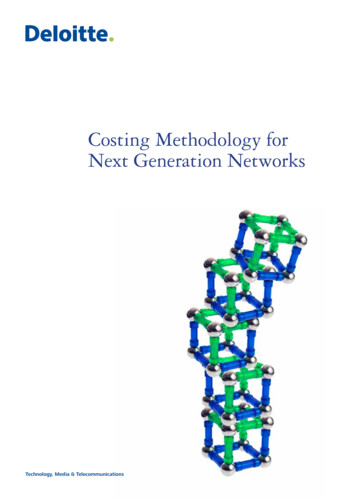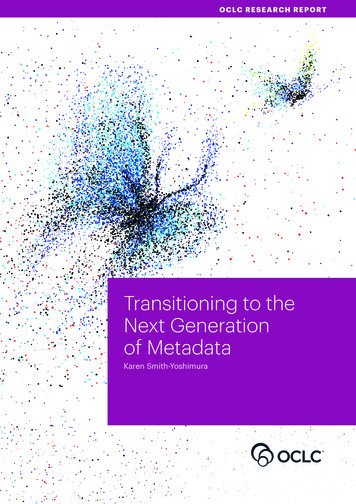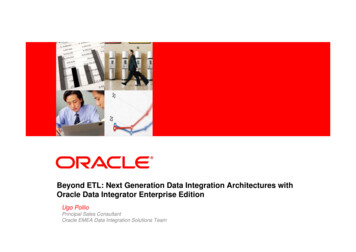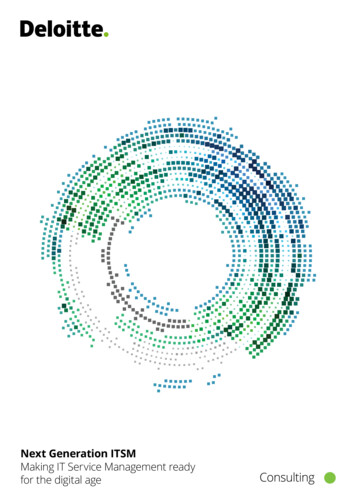
Transcription
Next Generation ITSMMaking IT Service Management readyfor the digital age
Investing in Germany A guide for Chinese businesses 02
Next Generation ITSM – Booklet Making IT Service Management ready for the digital ageExecutive Summary04Traditional ITSM and the DevOps Approach05Agile Adoption and Implementation06Combination of ITSM Frameworks with Agile Methods07DevOps Concepts for ITSM Processes08NextGen ITSM Collaboration Model11Service Management Platform14Contacts & References1503
Investing in Germany A guide for Chinese businesses Executive SummaryProcessPerspectiveITIL as only ITSM framework is nolonger sufficient to design a futureprocess map ITIL should be applied in combinationwith CMMI, COBIT, and the DevOps to efficiently support the digital transformationof an ITSM-based IT service process map Processes, which are affected by a strongcustomer interaction such as IncidentManagement, Problem Management,CollaborationPerspectiveITIL in combination with DevOps leadsto better results in digital operatingmodels It will become possible to identify andsatisfy user needs early on, collaborationwill be improved and inefficiencies andinformation losses at process interfacesreduced Traditional ITIL based organizations canapply DevOps approaches and tools toIntegrationPerspectiveAgile frameworks are helpful tofacilitate an enterprise adoptionApplication Management, Release andDeployment Management should berefined first Process refinement can be done centralor decentral: Incident Management andProblem Management should be adapted centrally for all IT services whereasChange Management and Release andDeployment Management should beadapted in line with the pace of the corresponding IT servicebecome more agile, utilize FeedbackLoops, Service Delivery Teams, and DevOps Engineers to empower collaborationand continuous communication within amodern IT department Use DevOps tools like interactive monitoring in combination with ChatOps,cross-functional KPIs or automation tomake ITSM customer-centric and moreagileshould constantly refine the establishedinterface between business and IT (e.g.for implementing new role concepts) On ITIL based ITSM organization canimprove their implemented processesby utilizing agile methods like SCRUM orby applying selected concepts out of theDevOps approach Companies that have already startedtheir digital transformation journey04 In case new processes or parts of existingprocesses are implemented, it is highlyrecommendable to use an iterative implementation approach (e.g. based on usecases). This will help to reduce complexityand strengthen the feedback loop to thecustomer
Next Generation ITSM – Booklet Making IT Service Management ready for the digital ageDevOps emphasizes people andculture and seeks to improvecollaboration between IT operationsand development teamsFig. 1 – The next evolutionary stages of ITSMStage 3: DevOps Enterprise Move from a silo approach to a high-trustculture (ability to fail without blame) Improved customer experience and designthrough stable servicesFast ITDevOps ITSMPace of theIT OrganizationStage 2: Agile Evolution More likely to exceed profitability,market share, and productivity goals Proactive consideration of customer feedbackthrough feedback and feed-forward loopsAgile ITSMStage 1: Status Quo Manual, resource intensive and siloedprocesses, inefficient hand-offs, lack of visibilityand auditability Demand for faster, more frequent andpredictable releasesClassic ITSMClassic ITlowAgile modehigh05
Investing in Germany A guide for Chinese businesses Agile frameworks are helpful tofacilitate an enterprise adoption andessential for an agile construct like aDevOps enterpriseFig. 2 – Barriers and foundations of an agile adoptionPotential barriers ofan agile adoption:Relevant foundationsof an agile adoption:Assignmanagementtask to theteamsITIL trainedmanagersand staffCounterintuitive behaviorof losing thecontrol aboutstructureUpfrontplanning ofITIL vs. agileflexibility06AgileculturalchangeUse agileframeworks(e.g. SAFe)to upscaleDevOpsEstablisha DevOpsenterprise
Next Generation ITSM – Booklet Making IT Service Management ready for the digital ageThe combination of ITIL with otherITSM frameworks and agile methodsleads to a dynamic and flexible ITservice organization How can ITIL support a dynamic andagile IT service organization and whyis this required at all? ITIL as a detailedand well established de-facto standardshows some gaps when it comes to itsagility and flexibility - e.g. its geared to thewaterfall approach, preferring sequentialprocesses rather than iterative ones.Fig. 3 – Agile ITSM Trend RadarHorizon 3: currently not in focusHorizon 3-2: might be relevant in a long term perspectiveHorizon 2-1: might be relevant in a mid term perspectiveHorizon 1-0: relevant in a short term perspective How to bridge these gaps without theneccesity to completely redesign ITIL- which would be an enormous effortand clearly not sufficient - will be onequestion to answer. There are severalstarting points: Combining ITIL with otherITSM frameworks such as COBIT or CMMIor applying agile methods like iterativeprocess implementation and scaling upwill lead to quick wins. Following the “start small then scaleup”-approach means to focus first on ITILprocesses which are strongly affected bychanging customer requirements (e.g.incident management, change management or application management). TheITSM trend radar provides an indicationon the most relevant or critical ITSMframework that should be assessed firstand which agile method can help to bringagility in the design of a future IT serviceprocess landscape.FitSMIT4ITDesign ThinkingCMMIeTOMESM3COBIT2ITSM Frameworks1)TechnologyCapabilityModel 2)1KanbanDigitalOperatingModels 1)ITIL0SAFeScrumDevOps123HorizonAgile Methods and FrameworksDeloitte Digital era Technology Operating ModelsDeloitte Effectiveness Technology Capability Model2)07
Investing in Germany A guide for Chinese businesses Traditional ITSM is based on ITILprinciples - future IT processes willbenefit from the quickness andflexibility that DevOps brings The common perceptions of ITIL andDevOps seem to contradict each otheron the first glance rather than illustratea perfect match: DevOps is agile, quickand collaborative while ITIL’s strength lieswithin the rigid and detailed definition ofprocesses, services and roles to manageand avoid risks rather than to learn fromthem. However, if evaluated carefully,both frameworks complement eachother. While executing DevOps which focuseson the realization of functional requirements (“features”), ITIL also ensures thatrequirements like availability, scalabilityand security are met by following provenprocesses and using well establishedmetrics and KPIs. The almost rigid and indetail described processes in ITIL evencreate the basis for automation – youcannot automate what has not been welldescribed previously. It is important to note that ITIL grants adegree of flexibility too. The frameworkoften solely describes what shall bedone, but not how (example: KPIs). Thisflexibility can be leveraged to make ITILmore agile, customer-centric and evencustomer-led by applying tools andmethods from DevOps.08Fig. 4 – Synergies between ITIL and DevOps featuresITILDevOpsConsiderationof UsabilityE.g. availability,scalability,and securityFocus onFeaturesQuick realizationof softwarefunctionalitiessupportsITILFocus onProcess DefinitionDetailed descriptionof requirements,processes, and rolesDevOpsenablesFocus on DeliveryAutomation oftesting anddeployment
Next Generation ITSM – Booklet Making IT Service Management ready for the digital ageDevOps complements ITIL with provenapproaches and modern collaborationtools to enable a more agile ITSMorganizationFig. 5 – Adaptation of DevOps tools in ITILicervSeCross-functional KPIsRather than separating Dev and Ops in Silos (or books), creatingconflicting infrastructure and service KPIs (e.g. uptime vs.time-to-market), cross-functional and result oriented KPIs need tobe set up, making Dev and Ops equally responsible for them, e.g.feature cycle timentemerovpImStandardization and AutomationFocus on resource optimization for higher speed and agilitythrough automation of testing, integration, and deployment,e.g. by usage of cloud provisioning toolsService TransitionDynamic and Interactive MonitoringDynamic and interactive kinds of monitoring, like ChatOps,create a direct touchpoint between Dev, Ops, and thecustomer. Thus problems can be identified, treated orescalated directly where they emerge, e.g. dashboardsrati onServiceStrategypeesignce DrviSeContinualDevOps ToolsServiceOOperational Feedback LoopsThe customer voice needs to be heard where it matters: in thedevelopment. This way, a higher customer satisfaction andreduced ticket counts are achieved, e.g. by applying a netpromoter scoreNew Idea of Ticketing SystemsDevOps takes a leaner approach to ticketing tools. In-toolprocesses needs to be streamlined and focus on benefits;monitoring has to be automated and integrated with theticketing tool for faster responses, e.g. ServiceNow09
Investing in Germany A guide for Chinese businesses Communication between Dev, Ops,and the customer is essential inmodern IT departments and can befostered by agile conceptsWith the integration of Dev and Ops, thecustomer voice is getting closer to thedevelopers who can react in a quick aneffective way. One tool facilitating this ideais the concept of Operational FeedbackLoops which utilize (1) a common platform(such as ChatOps), (2) transparency andintegration and (3) organizational changesto achieve continuous improvement ofprocesses, software, and services, leadingto a reduction of service disruptions,rapid reaction times to problems or newrequirements, and a more efficient use ofdevelopment resources.Fig. 6 – Operational Feedback Loops conceptUser2) Transparency & Integration:All stakeholders know the E2E processes andhave access to relevant resources; e.g. Devs know business processes, and areinvolved in testing early on Ops are involved in release planningand development processesDev1) Tool:Dev, Ops, and the user arecollaborating on a commonplatform (e.g. ChatOps). There iscontinuous and synchronousfeedback and the customervoice is heard where it matters.Ops103) Organization:Dev & ops members are combined toservice delivery teams, facilitated by theDevOps Engineer
Next Generation ITSM – Booklet Making IT Service Management ready for the digital ageDevOps helps ITIL to prepare ITSMorganizations for future IT challengesby softening borders betweenprocesses and roles To soften borders between processesand facilitate a cross-process workingmode, the introduction of the DevOpsEngineer (DOE) role – combining development and operational know-how –secures the application of DevOps principles across an entire service or servicebundle. Within a matrix working mode, the DOEperforms operational tasks in variousprocesses along his services. In doingso, entire processes are looked at from aservice perspective and not as commonly applied, only from an isolated processperspective, which uncovers inconsistencies across services and potentials toimprove efficiency. Hereby, the DOE will not replace any ITILroles but will closely collaborate withthem. For example, while the ServiceOwner’s job is the “initiation, transitionand ongoing maintenance and support ofa particular service”, the DOE’s responsibility is much more operational.11
Investing in Germany A guide for Chinese businesses Fig. 7 – The DevOps Engineer within the IT OrganizationSenior Responsible ServicesService Bundle 1:e.g. TelephoningService Bundle 2:e.g. PrintingService Manager (strat.)Service Manager (strat.)Service Manager (strat.)Service Responsible (oper.)Service Responsible (oper.)Service Responsible (oper.)SCRUM MasterSCRUM MasterSCRUM MasterSCRUM TeamService LevelManagementSCRUM TeamSCRUM TeamService Level ManagerDevOpsEngineer 1DevOpsEngineer 2DevOpsEngineer nConfigurationManagementProcess OwnersSenior Responsible ProcessesChangeManagementService Bundle n: EventManagementIncidentManagement Technical (overarching)DevOps Topics12Senior Responsible ArchitectBU CustomerBU ProviderIT
Next Generation ITSM – Booklet Making IT Service Management ready for the digital ageAgile process implementation allowsCIOs to refine their IT operatingmodel based on use cases and initerative stepsFig. 8 – Agile Incident ManagementAgile Incident Management (Example)Detection andRecognitionClassification andInitial ReportInvestigation andDiagnosisResolution andRecoveryIncidentClosureEnd User CommunicationDetermining factors:Tab. 1 – Exemplary backlog Process architecture: ITILThemeProcess Area Process GroupUser StoryPriorityComplexity Amount of process groups: 6ServiceOperationIncidentDetection &RecognitionAs a user I want toreceive Incidentsover a ServiceCockpit where Ican assign themto the icationAs a user I want tobe able to accessa Dashboard tomonitor the statusof my reportedincident35 Backlog: centralized and prioritizedaccording to value expected and riskreduction Backlog refinement is done by a defined(change) board Sprint process as known Result: lean but operationalized processby defining use cases (e.g. passwordreset) which is implemented end to end13
Investing in Germany A guide for Chinese businesses Drive digital transformation with theServiceNow platform to improve theway teams work together in a modernenterpriseFig. 9 – Enterprise Service Transformation with ServiceNowAllow Cross-functionalCollaboration We manage large businesstransformations We define cross-functionaloperating modelsDigitize & Automate Processes We create business value andgenerate ideas in our DigitalFactory and ServiceNowCreator Lab We provide industry insights aswell as ServiceNow (process)best practicesDeloitt
process map ITIL should be applied in combination with CMMI, COBIT, and the DevOps to effi-ciently support the digital transformation of an ITSM-based IT service process map Processes, which are affected by a strong customer interaction such as Incident Management, Problem Management, ITIL in combination with DevOps leads to better results in digital operating models It will become .

